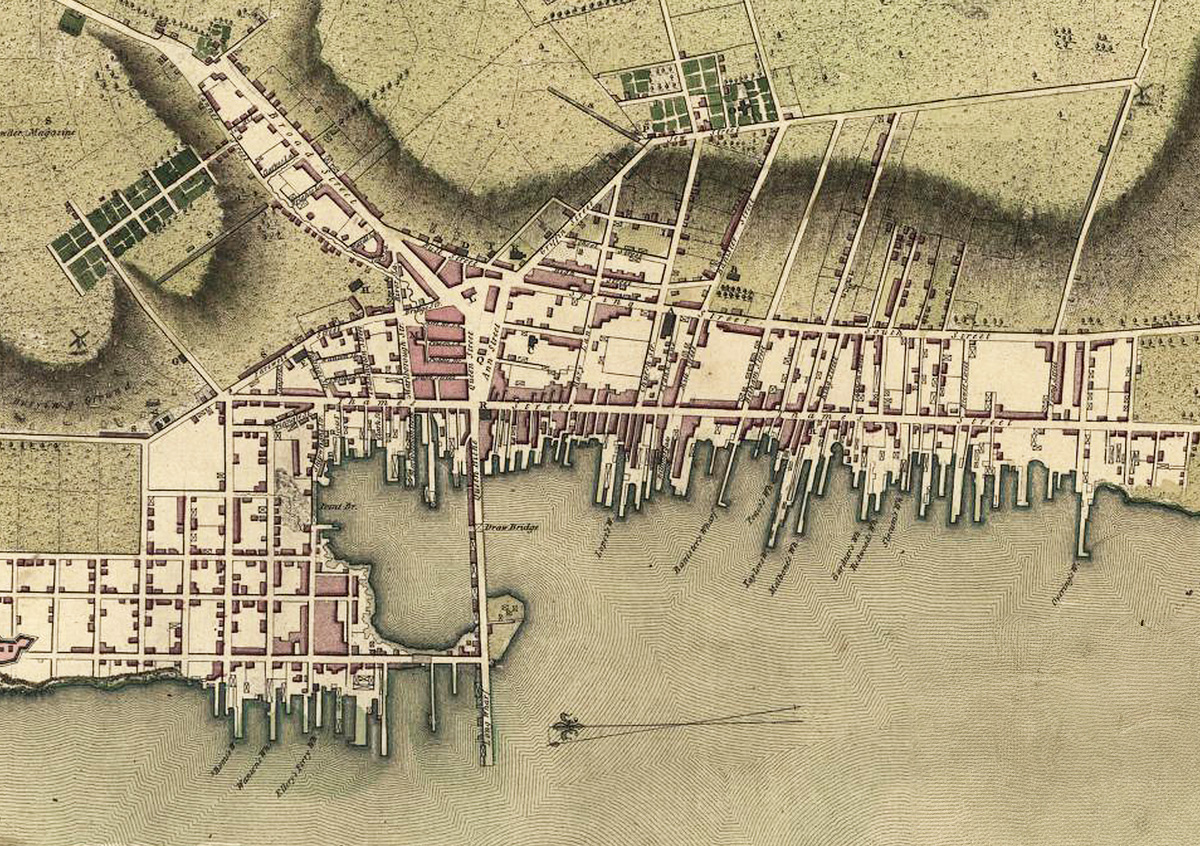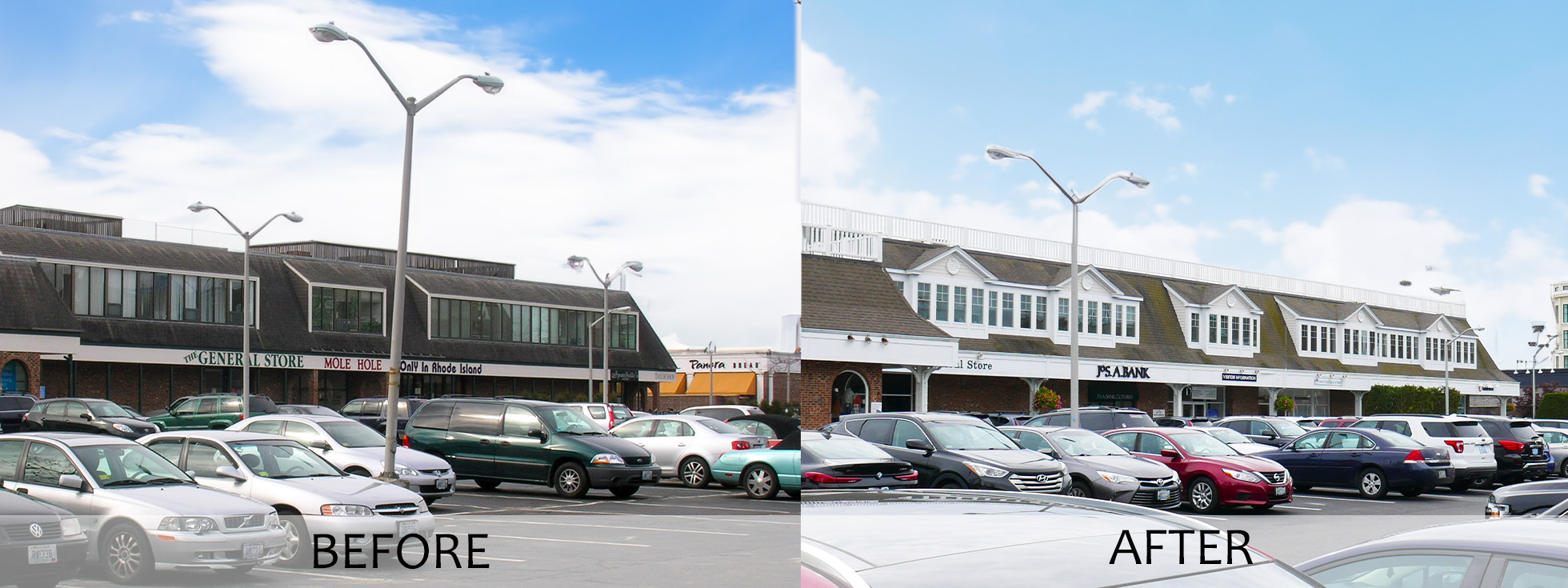Long Wharf Mall (Newport, Rhode Island)
When Newport was first founded in 1639 upon the discovery of a freshwater spring near the deep-water harbor, there was one main road connecting the spring to the water: Long Wharf. This wharf extended out into the Narragansett Bay and was where all the boats docked to bring goods to and from the small colony built at the edge of the Atlantic Ocean.Top of Form
Over the years, wharf generated huge amounts of trade and wealth for the inhabitants of the city and by 1776, Newport was the fifth largest city in the American Colonies, and one of the wealthiest per capita. It was a center of fine furniture Craftmanship (including the famous Townsend and Goddard shops), a center of religious freedom in a world where sectarian conflict was nearly universal, thriving, and a growing community.

1777 Blaskowitz Map of Newport, RI
The advent of the American Revolutionary war unfortunately had a serious negative impact on the community as British forces seized the city in December of 1776 to establish a protected naval and military foothold. By the time the American insurgents (with the strong assistance of the French Navy) were able to wrest control of the city, back in October of 1779, half the population of Newport had fled, and Newport would never again be among the largest cities in the American Colonies of States.
Long Wharf, however, continues to be a control artery in the community and its primary East-West axis to the water, which was the lifeblood of this city “City by the Sea,” for the next 190 years.

Before & After View Looking Down Long Wharf Mall (Newport, Rhode Island)
In 1968, after being connected to the mainland primarily by ferry, the Pell Bridge was constructed for the first time began the flow of automobile traffic in and out of the city directly from the mainland. To accommodate this greatly increased traffic, and in alignment with the planning ideas of that era, a pair of two-lane highways was constructed from the new bridge into the middle of Newport.
This insertion caused the demolition of dozens of colonist structures, divided the waterfront from its historic neighborhoods and dumped large amounts of automobile traffic into a colonial sealed neighborhood that were ill-suited to absorb the vehicles.

Before & After Facing Long Wharf North (Newport, Rhode Island)
The urban intervention also caused the clearing of Long Wharf from its traditional connection to the waterfront. The old municipal buildings were demolished a new, anonymous mall structures were built to try to recapture the retail business that was flowing at the time to large suburban and urban malls. In retrospect, many mistakes in urban design were made at that time and the city and neighborhood have been combatting the unexpected consequence ever since. Long Wharf, as was fashionable at the time, was converted into a “pedestrian mall” with the large planters and landscaping blocking the traditional axial relationship between the waterfront and Washington Square, the historic civic heart of the city.

Before & After From America Cup Ave. (Newport, Rhode Island)
By 2004, when a new owner purchases the buildings which lay at the north side of this moribund pedestrian mall, the center was half empty and many of the remaining businesses were close to failing. The center was overgrown, uninviting and need more than a facelift, but a complete repositioning. A4 Architecture was hired to revision how this 1960’s structure could be redesigned to look like it belonged in the heart of one of the most historic cities in America.
The firm studied colonial and Victorian Era warehouses and stables and applied those rooflines upon the modern building. This allowed the sign band to be more than doubled in size and new gobbled dormers were added to help break up the enormous mass of the original structure, which looked like an aircraft carrier that had been dropped on the site.

Before & After of Side Entrance of Long Wharf Mall (Newport, Rhode island)
The decrepit concrete planters and sickly landscaping was removed to open the visits between the waterfront and Washington Square. Traditional copper gooseneck sign lights were added to not only illuminate the new larger signs, but to also illuminate the ground to make the center feel safer and more inviting in the evenings and on dark winter days.
Columns were added to give not only more traditional character to the building, but also to provide a way to hang flower baskets and blade signs to help draw visitors into the center. In a hundred subtle ways the design was improved, and the renovation worked; vacancies dropped to zero, customer traffic increased, and rents rose consistently over time. Now the center is once again a vital link between the waterfront and the historic Washington Square.

Before & After From W. Marlborough St. (Newport, Rhode Island)
The project was also the first of more than a dozen that A4 Architecture has done for that property owner, and the relationship has been a long and fruitful one for both parties.
While the center is not the one, we would have designed from scratch, in the world of architecture and urban planning, the designer is presented not with a blank slate, but with a complicated amalgam of existing conditions. It is their challenge to make the maximum improvement with the resources available and avid (like the poorly considered construction of American Cup Boulevard) the destruction of important historical assets and relationships.
Ross Cann, RA, AIA, LEED AP, is an author, historian, teacher and practicing architect living and working in Newport, RI. He holds degrees in Architecture and Architectural History from Yale, Cambridge, and Columbia Universities.
